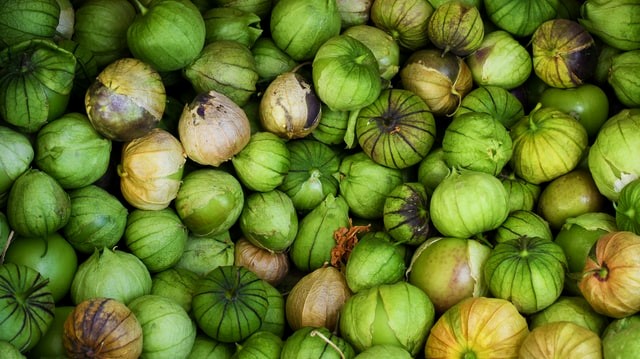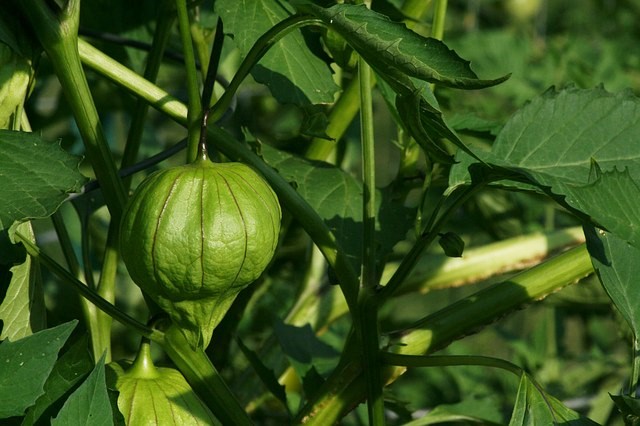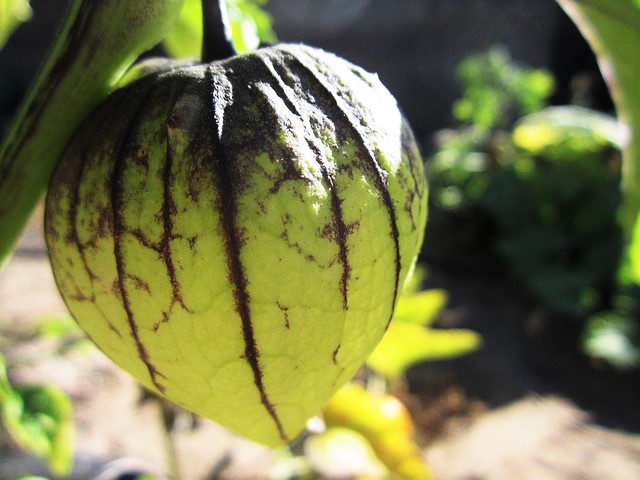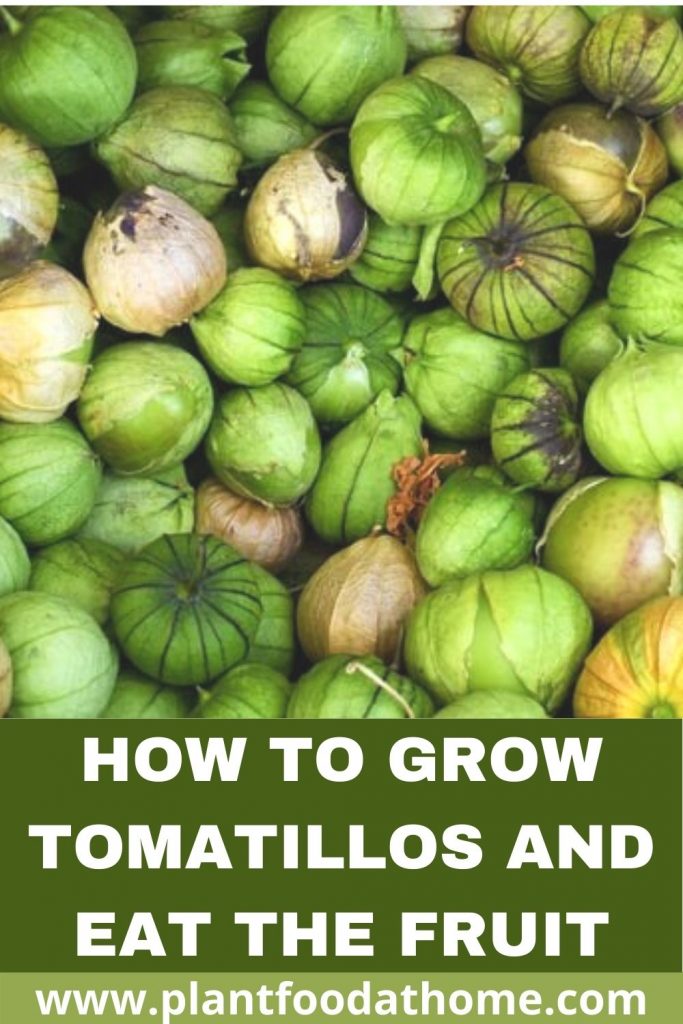Tomatillos; you may have noticed these green tomato-like vegetables in the produce department of your local supermarket. Despite its growing popularity, many people aren’t quite sure what a tomatillo is or how to eat one. In this article, we’ll be discussing growing your own tomatillos and how to eat them with a few recipe ideas to try.

As a gardener, I understand how exciting it is to try growing a new crop. When I first started growing tomatillos, I was just looking for a fun experimental crop to grow in my garden. Now, I find tomatillos are an absolute must-have! They’re a versatile fruit, and I love the tangy sour flavor they have.
Table of Contents
- Tomatillo Plant Profile
- Tomatillo Varieties
- Quick Guide to Planting Tomatillo
- Ideal Growing Conditions for Tomatillo
- Growing Tomatillo From Seed
- Tomatillo Plant Pollination
- Harvesting and Storing Tomatillo
- What Does a Tomatillo Taste Like & How Do You Eat A Tomatillo
- Pests & Diseases
- Frequently Asked Questions
- Conclusion
- Some Favorite Gardening Products
Tomatillo Plant Profile
Tomatillos (otherwise known as Physalis Philadelphica ) originate in the hot region of Mexico and Central America. They are also called Mexican Husk Tomato, Mexican ground cherry, miltomate, Mexican green tomato, and large-flowered tomatillo.
In hot climates such as USDA zone 10 & 11, a tomatillo plant can be grown as a perennial. And, for gardeners living in lower zones, tomatillos are grown as an annual.
Tomatillos are members of the nightshade family, Solanaceae, which include tomatoes, eggplant, potatoes, and bell peppers among others.
Some of the larger varieties of tomatillos can grow up to 6 feet (1.8 meters) tall. Though on average, most tomatillo plants range from 3 to 4 feet (90-120cm) tall. Its bushy foliage produces beautiful serrated green leaves. Tomatillos produce blossoms of tiny yellow and black flowers.
The tomatillo fruit itself is a small, tomato-like fruit that grows on average 1 to 2 inches in diameter. Typically, the tomatillo is a vibrant green, but some varieties produce purple tomatillos. Covering the tomatillo fruit is the husk, a papery outer cover with a yellow-green appearance. The husk is inedible and needs to be peeled before eating.
Tomatillo Varieties
Toma Verde: The Toma Verde variety of tomatillo is a classic variety, just about the most basic tomatillo you can grow. Like most other varieties, the Toma Verde is a highly productive variety of plant and you can enjoy a massive harvest of tomatillo.
Cisineros Grande: Go big or go home with this large variety of tomatillo. This variety is highly productive and produces large tomatillos about the size of a golf ball. The plant itself grows between four to six feet ( 1.2-1.8 meters) tall, so definitely make sure you have room in the garden to house this big beauty.
Purple: Similar to the classic green variety, but with a fun twist. This variety grows tomatillos with a striking purple hue. It definitely turns heads when made into a salsa. Grow this variety in a sunny location, as the sunshine further intensifies the purple color. Its flavor is slightly sweeter than the more classic green varieties.
Quick Guide to Planting Tomatillo

Plant according to your area’s frost schedule
Tomatillos are a frost-sensitive crop. Fruit and foliage production is highly dependent on warm weather. You can plant tomatillos directly in the garden after all danger of frost has passed. And if you want a head start, you can start your seedlings indoors 6 to 8 weeks prior to the last frost date and transplant when the time is right.
Choose the right spot for planting tomatillo
Make sure your tomatillos are planted in a location with lots of sunlight; at least 8 hours for maximum growth and fruit production. Tomatillo plants can grow very tall, so it is important to ensure that you’ll have ample space to accommodate its size as well as some support such as a trellis.
Amend soil if necessary
Tomatillo plants are rather tolerant of many soil conditions, and they do not require heavy fertilization. Simply working in some compost and aged manure before planting is enough to sufficiently feed your tomatillo plant.
Plant more than one tomatillo!
Tomatillos require cross-pollination with another tomatillo plant. So in order to grow tomatillos, you should plant a second or third tomatillo plant to pollinate each other.
Ideal Growing Conditions for Tomatillo
Climate for Tomatillo Plants
Tomatillos adore hot climates and are very sensitive to the cold. The ideal daytime air temperature for tomatillos would be around 80-90°F (26-32°C). And the ideal nighttime air temperature would be around 60-70°F ( 15-21°C). Humidity is not a primary concern when it comes to growing tomatillos.
Soil Requirements for Growing Tomatillo
Tomatillo plants are not picky about their soil preferences, as sunlight and heat are more important to their growth. However, the ideal soil for tomatillos is well-draining, fertile soil with a temperature between 70-80° F (21-26°C). Tomatillos prefer a more neutral soil pH, with a level between 6.5 and 7.0.
Sun Requirements for Growing Tomatillo Plants
Tomatillos absolutely love the sunlight. To make sure your tomatillos are happy and provide a highly productive harvest, it is best to plant your tomatillos in a location that receives at least 8 hours of sunlight a day.
Water Requirements for Tomatillos
As a crop that originated in the hot climate of Mexico, the tomatillo plant is drought tolerant. Despite this, it is still a good idea to give your tomatillos around 1 inch of water on a weekly basis.
Fertilizer for Tomatillo Plants
Conveniently, tomatillos do not require a fertilizer regiment as they are very light feeders. However, if you do want to fertilize tomatillos, you can always work in some compost and aged manure prior to planting.
Growing Tomatillo From Seed
While tomatillos are becoming more well-known, it is still rather difficult to find tomatillo starter seedlings at your local nursery. Luckily, growing tomatillos from seed is extremely easy.
Tomatillos can be started from seed directly in the garden or started indoors 6 to 8 weeks prior to the last frost. The one important thing to keep in mind is to plant the tomatillos (seed or seedlings) outside after all frost danger has passed. Tomatillos are sensitive to cold temperatures and a surprise frost will be the end of your young plants.
As you will soon notice, tomatillo seeds are very small. The ideal planting depth for these seeds is about 1/4 inch (6mm) deep. Germination of these seeds takes between 7 to 14 days to see sprouts. And your tomatillo plants should be fully matured in about 75 to 100 days.
Plant tomatillos about 2 feet (60cm) apart in the garden. And plan to provide a trellis or a tomato cage to support them and their heavy fruit set.
Tomatillo Plant Pollination
As mentioned earlier, tomatillo plants need to cross-pollinate in order to produce a harvest. Plant a second tomatillo plant in order to produce a great harvest of fruit. But 3-4 plants is even better!
Unlike tomato plants which are self-pollinating, tomatillos require pollen to be transferred from one flower to another flower grown on different tomatillo plant.
The best pollinators are bees as well as other beneficial insects in the garden. Planting flowers or other flowering edibles will attract more bees and beneficial insects to help pollinate your tomatillo plants. You might like to try growing nasturtium flowers with our guide here.
You can also hand pollinate tomatillo flowers with a small dry brush or q-tip. Use the brush to gently brush the pollen inside the flower and then using the same brush, do the same with some of the other tomatillo plant flowers.
Hand pollination is a little time-intensive for the small tomatillo flowers so it’s preferable to work on attracting pollinators to help do the job for you.
Harvesting and Storing Tomatillo

The best way to determine if your tomatillos are ready to be harvested is by examining the outer husk that houses the fruit.
Often, when the tomatillo is mature, it will grow out of the husk, causing it to split open. Or the tomatillo will fill out the husk which will turn a lighter shade of green or brown and become paper-like. In this case, the tomatillo inside is ready and can be harvested.
If you notice that the tomatillo has turned a pale yellow color, then unfortunately that tomatillo is no longer edible. At this stage, the interior is seedy and the signature tangy flavor is lost.
In a good season, one tomatillo plant can produce an amazing harvest of up to 10 pounds (4.5kg) of fruit.
Tomatillos can be stored like tomatoes. They can be kept out at room temperature for up to one week. You can also opt to keep them loosely stored in a paper bag for three weeks, but avoid keeping them in a plastic bag.
What Does a Tomatillo Taste Like & How Do You Eat A Tomatillo
The tomatillo is well known for its distinctive sour taste and can be eaten both raw or cooked. Some people find the taste compares to other sour fruits such as green grapes or Granny Smith apples.
When you’re ready to start cooking with your tomatillos, the first thing you should do is peel off the outer husk. This should be very easy, the husk comes off with little resistance, and the stem should be plucked off as well.
You may notice that the peeled tomatillos have a very sticky texture, this can be easily washed off with a rinse of lukewarm water. After the tomatillos are prepared, you can approach them just like you would with any tomato for cooking.
While tomatillos are well known to be the star ingredient of salsa verde, they’re extremely versatile and can be used in a multitude of dishes. As the tomatillo originated primarily in Mexico, they are a beloved staple of Mexican cuisine.
Salsa Verde Recipe
I absolutely love this simple yet versatile recipe for salsa verde. I eat it on my eggs, I dip chips in it, I even use it as a salad dressing. Really it can be used for anything!
Ingredients:
5 to 6 tomatillos, cut in half
1 white onion, peeled and cut in half
3 cloves of garlic
2 Hot peppers of your choice (I prefer a mix of jalapeño and serrano, remove seeds if you’re not a fan of the heat)
1 cup of chopped cilantro
Juice of half a lime
Salt to taste
What you need:
A frying pan (nonstick preferably)
Directions:
1. In a hot pan, place the tomatillos, the onions, the garlic, and the peppers.
2. Allow each side to brown, getting a nice char. Flip over once and cook on the other side.
3. When cooked to your preference, take the pan off of the heat and allow the ingredients to cool.
4. In a blender, add lime juice and a splash of water to the bottom.
5. Add the cooled ingredients, followed by cilantro and salt.
6. Turn the blender on and pulse until desired consistency.
Recipe Ideas Using Tomatillos
If you’re looking for more ways to use your tomatillos, here are some recipes to try:
Fresh Tomato & Tomatillo Salad – from My Food Family
Oven Roasted Tomatillos – from Brooklyn Farm Girl
Pests & Diseases
The amazing benefit of growing tomatillos is that it has very few pests or disease threats. Regardless, let’s take a look at some of them so you’ll know how to prepare yourself if you do run into any issues.
List of Pests
Aphids: Aphids are an occasional pest you might experience with not only tomatillo plants, but many other crops as well. You can identify these tiny pests by their green or black bodies. They show up in abundance, typically under leaves. Aphids are an easy pest to get rid of naturally. Simply spraying them with a jet stream of cool water is enough to shake off the pests once and for all.
Whiteflies: Very similar to aphids, whiteflies are a small pest that comes in large quantities. They also attack the underside of the leaves and are identifiable by their small white fly appearance. Whiteflies are particularly dangerous because they can sometimes carry disease which spreads by contact. Luckily, just like aphids, whiteflies can be deterred with a simple dousing of water.
In addition, tomatillos may also be susceptible to slugs, snails, or beetles. My personal method of deterring these pests is covering the plants with a good quality row cover. Row covers can be purchased in your local home improvement store or online such as this row cover here. It’s natural and does not introduce any harmful pesticides into your garden.
List of Diseases
Black Spot: Black spot is a fungal disease that primarily attacks the leaves of the tomatillo plant, the fruit may be affected in severe cases. Black spot can be controlled by applying a natural fungicide to the plant. Some examples of natural remedies to alleviate black spot include sulfur, neem oil, and copper. Of course, most fungal diseases that attack plants can always be prevented with proper air circulation!
Frequently Asked Questions
Are tomatoes and tomatillos similar?
This is definitely a question that’s on a lot of peoples’ minds. Tomatillo vs. Tomato: Your first instinct when you see a tomatillo might be to compare it to a tomato. While tomatillos are not actually tomatoes, they’re definitely related and share many similarities. Tomatillos and tomatoes are members of the nightshade family. Nightshades all contain a toxic alkaloid compound that is shared by all other members of the nightshades.
If tomatillos are nightshades, then are they toxic?
While nightshades all share a toxic alkaloid that can cause harm, there’s no reason to be alarmed. The toxic alkaloid is only present in the husk, stems, and leaves, not in the tomatillo fruit itself. That’s why you can eat nightshade fruits safely!
You would have to consume a large quantity of foliage to cause any damage. Not only that, but the foliage is bitter and unpalatable, so the likelihood you or an animal will consume enough to cause you any harm is virtually nonexistent.
Conclusion
Once you harvest your first crop of tomatillos, you are sure to fall in love with them just like I have. Tomatillos are easy to grow, so go ahead and give tomatillos a try in your vegetable garden.
Some Favorite Gardening Products
- Felco Garden Pruners
- AeroGarden Bounty Indoor Hydroponic Herb Garden
- King Bird Raised Garden Bed
- Sloggers Waterproof Garden Gum Boots
- Horticultural Neem Oil
Further Reading:
- How To Grow Tomatoes In Pots
- How To Grow Eggplant: Planting, Harvesting, And Recipe Ideas
- How To Grow Okra: Planting, Caring, And Harvesting Okra
- What’s Eating My Cape Gooseberries?
- How to Grow Cape Gooseberry
- Growing Jalapenos: Planting and Harvesting Jalapeno Peppers
- Okra Dying? Common Causes and Solutions!

